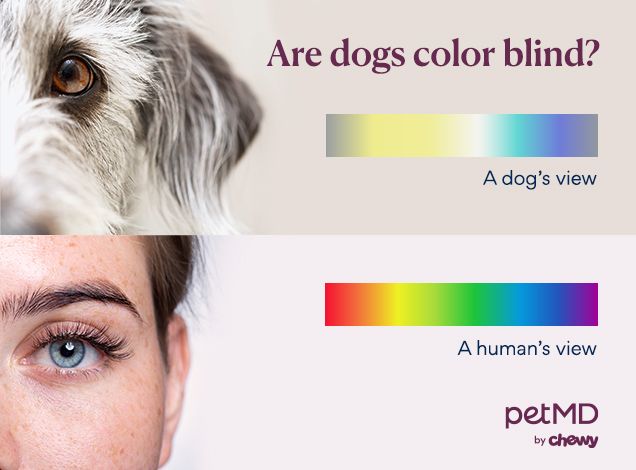Have you ever wondered what the world looks like through your dog’s eyes, or wondered if dogs can see all the colors of the rainbow? Have you ever asked yourself the question: “Are dogs color blind?” You are not alone.
Color blindness and color vision in dogs have been extensively researched and while we don’t know everything, we can give you some answers to these questions.
key takeaways
- There is some research on color blindness in dogs; but we still have more questions than answers.
- The dog’s color vision is described as dichromatic, or “bicolor.”
- Dogs have a limited view of the world compared to humans.
Color blindness in dogs: fact or fiction?
First, you will need to understand how the eye works. The eye is made up of specialized cells and receptors called rods and cones. The rods are responsible for detecting movement and aiding vision in different shades of light, while the cones help differentiate color.
People have three types of cones, while dogs have two. This means that people can typically identify three color combinations (red, blue, and green), while dogs are limited to two (yellow and blue). Therefore, the dog’s color vision is described as dichromatic or “bicolor”.

What is color blindness?
Color blindness describes an inability to differentiate between colors or to see certain colors at all. This condition stems from an abnormality in the color detection receptors in the eye.
In people, there are two types of color blindness: red-green color blindness and blue-yellow color blindness. The type a person has depends on which color sensitive receptors are affected. For example, a person with red-green color blindness cannot differentiate between those two colors.
So what is the truth about color blindness in dogs?
Having yellow-blue dichromatic vision means dogs are more similar to a red-green colorblind person. They are very good at distinguishing between variations of blues and yellows (and whites and grays), but they really can’t see red and green very well.
How do we know this?
Some types of studies have investigated the structure and function of the dog’s eyes to identify the types of cones that are present and to observe how they react to different wavelengths of light. Scientists have also used behavioral studies to test color vision in dogs. Some involve training dogs to respond to color cues for food rewards, while others monitor how a dog’s eyes, head and body orient to the movements of colored objects.
What colors can dogs see?
Dogs and humans see and experience color differently. Being dichromatic means that a dog’s color perception will be limited compared to humans.
Research leads us to believe that dogs see the world through a unique color spectrum. Yellow and blue are the dominant colors in the dog’s color vision. Blue, blue-green, and purple all look like different shades of blue. Shades of red and green probably look more like browns and grayscale to a dog.

Compared to people, dogs also don’t see as clearly and can’t tell differences in brightness as well, which probably makes the world look a bit dull and blurry to them.
But canine vision is superior to ours in other ways. They are much better at detecting motion and can also see more clearly in low light conditions, when shades of gray predominate and having good color vision doesn’t offer much benefit.
Featured image: iStock.com/Iuliia Zavalishina

